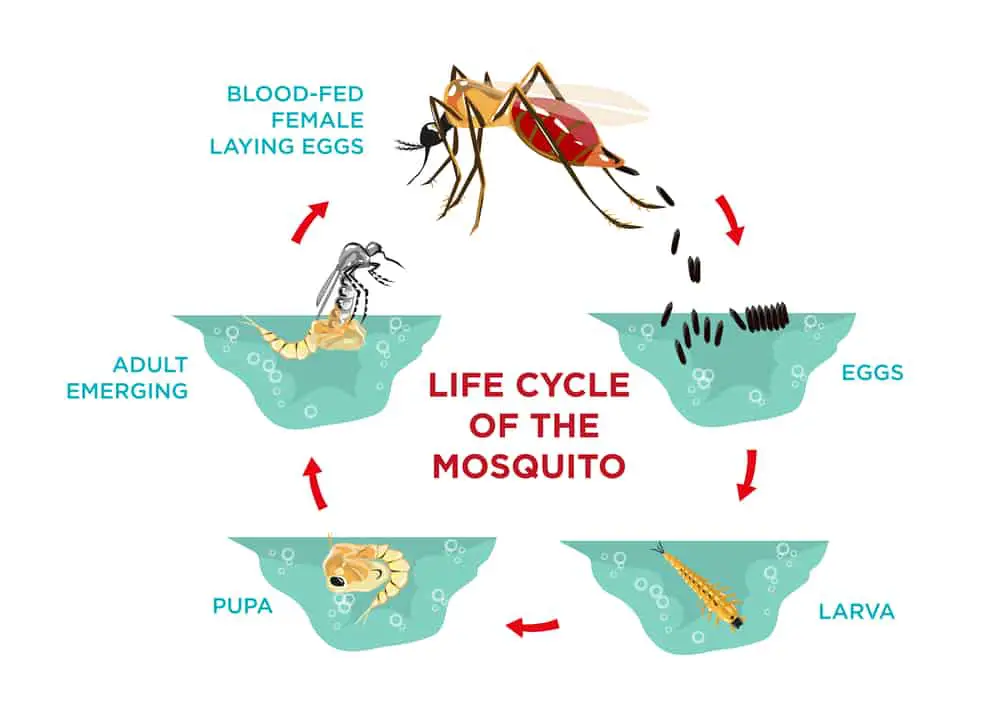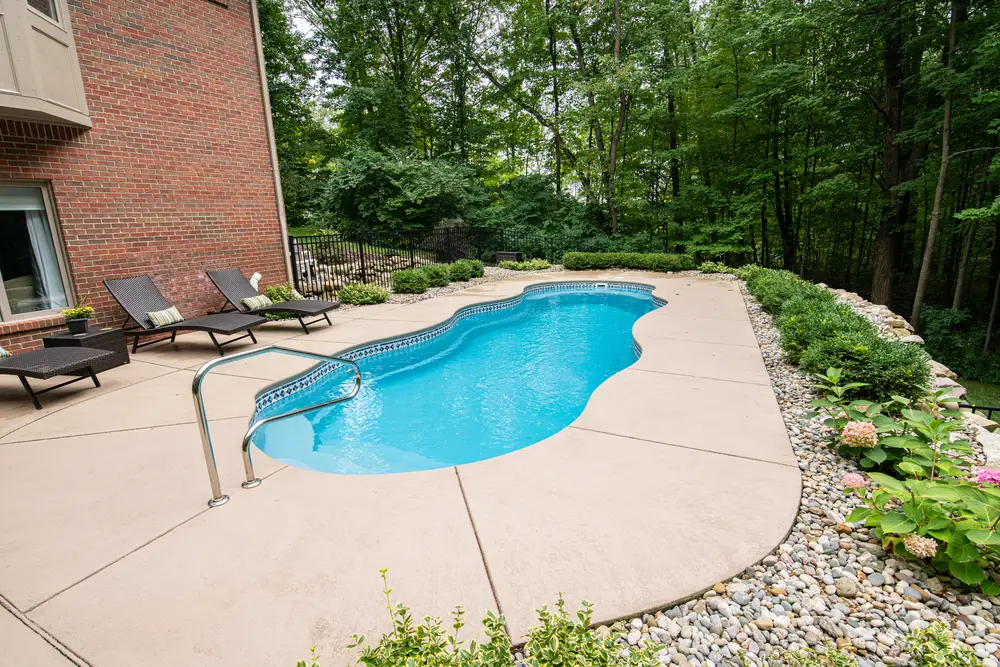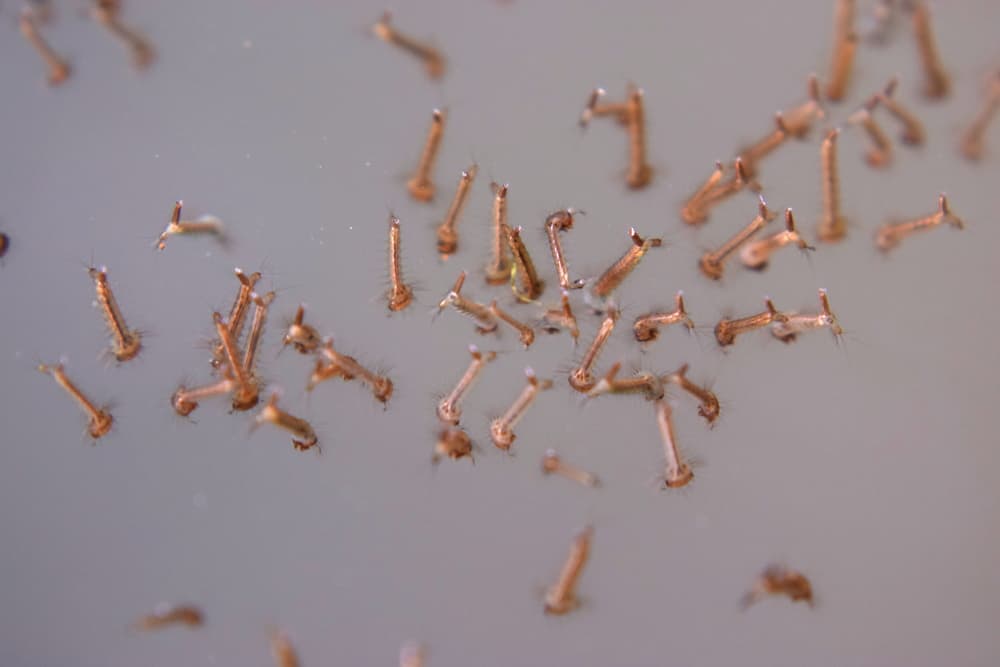Mosquito larvae are a common issue for many pool owners, especially during the warmer months when these pesky insects lay their eggs in standing water.
To keep your outdoor oasis mosquito-free, it is critical to eliminate and prevent these larvae from thriving in your pool. One possible solution is whether or not bleach can kill mosquito larvae.
Bleach, or sodium hypochlorite, is a powerful oxidizing agent known for its disinfectant and sanitizing properties. It is commonly used to keep swimming pool water clean and well-maintained. Although chlorine is typically used in pools, bleach is essentially a more diluted form of the chemical, making it a potential alternative for killing mosquito larvae.
Understanding Mosquito Life Cycle

Eggs to Pupae
Mosquitoes have a life cycle consisting of four stages: egg, larva, pupa, and adult. Female mosquitoes lay their eggs in or around standing water or moist areas. Within days, the eggs hatch, and mosquito larvae emerge. These larvae, often called “wigglers,” feed on organic matter and microorganisms in the water.
As they grow, they molt several times before reaching the pupal stage. The pupa is the transitional stage between the larval and adult forms.
Breeding Grounds
Mosquitoes rely heavily on standing water or moist environments to complete their life cycle. The breeding ground can be anything that holds water for an extended period, such as ponds, pools, containers, and even old tires.
It is critical to eliminate these sources of standing water, as they provide an ideal environment for the development of mosquito larvae and pupae.
Infestation
A mosquito infestation occurs when the breeding grounds are left unchecked, allowing the mosquito population to rapidly multiply. In addition to their annoying bites, mosquitoes can transmit diseases to humans, underscoring the importance of controlling their numbers.
Knowing the mosquito life cycle and addressing potential breeding sites can play a significant role in controlling infestations.
To break the life cycle of mosquitoes and reduce the number of larvae in pools or other areas of standing water, consider using methods like employing mosquito dunks, introducing natural predators, or adding chemicals like bleach.
Please note that while bleach can be effective in killing mosquito larvae, it should be used with caution as it can also harm the surrounding environment.
Effectiveness of Bleach in Killing Mosquito Larvae
Bleach and Chlorine
Bleach is a common household product that contains chlorine, a powerful chemical agent known for its disinfecting and cleaning properties. In a swimming pool, chlorine is a popular choice for water sanitation, which helps to kill bacteria, algae, and other microorganisms that can compromise the health of those using the pool.
When it comes to mosquito larvae, bleach can be an effective solution to eliminate these pests from your pool. By adding bleach to the pool water, the chlorine levels increase, creating an environment that is toxic to mosquito larvae. As the larvae are exposed to chlorinated water, they will die off, reducing their population and preventing the growth of new mosquitoes.
Toxicity and Safety Concerns
Using bleach for mosquito larvae control in your pool must be done with caution. Excessive amounts of bleach can be toxic to humans and the environment. When chlorinating your swimming pool, it is crucial to maintain the appropriate water balance, ensuring that the chemical concentration is safe for swimmers.
Here are some guidelines for using bleach effectively and safely:
- Carefully read and follow the instructions on the bleach label for proper usage and dosage.
- Frequently test and monitor the chlorine levels in your pool, aiming to maintain a concentration of 1 to 3 parts per million (ppm).
- Avoid swimming in the pool if the chlorine level exceeds 5 ppm to prevent skin irritation and eye discomfort.
Alternative Methods to Eliminate Mosquito Larvae
Using Mosquito Dunks and BTI
One effective way to control mosquito larvae in pools is by using mosquito dunks and Bacillus thuringiensis subspecies israelensis (BTI). Mosquito dunks contain BTI, a natural bacterium that specifically targets mosquito larvae without harming other wildlife or the environment.
You can simply place a mosquito dunk in standing water, such as a pool, pond, or even birdbaths and gutters, where mosquito larvae are likely to thrive.
BTI works by releasing toxins that target the larvae’s digestive system, effectively killing them while leaving other organisms unharmed. Remember to regularly check and replace the dunks, especially after heavy rainfall, to maintain effective mosquito control. Although BTI is safe for pets and wildlife, it is still important to keep them away from treated water.
Natural Remedies
There are several natural remedies to eliminate mosquito larvae in your pool and backyard. Adding a few fish to your pond is one option. Fish, such as koi and goldfish, eat mosquito larvae and pupae, helping to control the mosquito population in the water. Furthermore, adding fish to your pond can benefit the overall ecosystem.
Some natural oils can also help in controlling mosquito larvae. For example, cinnamon oil can be added to standing water to kill mosquito larvae. Additionally, citronella oils, rosemary, and lavender are known to have mosquito repellent properties. You can plant these around your backyard or use them in lanterns to keep mosquitoes at bay.
Another method involves using a mixture of white vinegar, apple cider vinegar, or vegetable oil added to stagnant water. The oil or vinegar forms a thin layer on the water’s surface, suffocating the mosquito larvae and preventing the development of more.
However, when using these remedies, be cautious not to overuse them, as they may harm aquatic plants and other wildlife.
Keeping your lawn and grass well-trimmed helps decrease mosquito populations in your backyard. Remove any standing water in containers, such as buckets, to discourage the breeding of mosquitoes. Similarly, cleaning birdbaths, koi ponds, and gutters, as well as preventing algae growth, can also help control mosquito larvae.
Maintaining a Mosquito-Free Pool Area

Proper Pool Cover Usage
Using a pool cover can also prevent mosquito infestations in your pool.
A tightly fitting cover can help discourage mosquitoes from laying their eggs in the water. Pool covers reduce the surface area that is exposed to the air, making it more difficult for mosquitoes to access the water. Remember to remove standing water on the pool cover, as just 5 liters of water can become a breeding ground for mosquitoes.
Cleaning Pool Surroundings
Mosquitoes are attracted to dark and damp areas, which is why it’s important to maintain an environment that is less appealing to these pests.
One way to do this is by regularly cleaning your pool area using the following tips:
- Regularly clean the filter: Keeping your pool’s filtration system in good condition is essential for maintaining proper disinfection levels in the water. Clean and replace pool filter cartridges as needed to ensure optimal performance.
- Remove leaves and debris: Clear the area around your pool of fallen leaves and other organic matter that can collect moisture, as it can become a breeding ground for mosquitoes. Using a pool net, skim the surface of the water and remove any floating debris.
- Keep planters well-spaced and clean: Mosquitoes often lay eggs in stagnant water found in planters, so it’s essential to frequently check the water in planters, emptying and cleaning them regularly. Space planters evenly around the pool area to avoid water collecting in one spot.
- Sweep and hose down surroundings: Regularly sweeping and hosing down your pool deck and surrounding areas can help keep the space free of stagnant water, making it less inviting for mosquitoes.
Additionally, using an automatic pool cleaner can help keep the pool area tidy and free of debris. Make sure to shock the pool whenever the disinfection levels are too low, but always follow the manufacturer’s instructions.



